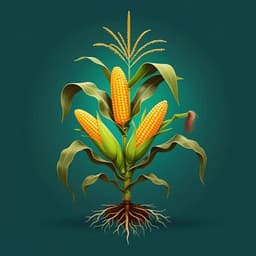
Agriculture
Plant diversity effects on forage quality, yield and revenues of semi-natural grasslands
S. Schaub, R. Finger, et al.
Discover how plant diversity transforms semi-natural grasslands! This groundbreaking research by Sergei Schaub, Robert Finger, Florian Leiber, Stefan Probst, Michael Kreuzer, Alexandra Weigelt, Nina Buchmann, and Michael Scherer-Lorenzen reveals that higher plant diversity leads to increased forage quality, yield, and revenues, challenging conventional agricultural views. A must-listen for everyone interested in sustainable grassland management!
~3 min • Beginner • English
Introduction
Grasslands are critical for global food security and underpin milk and meat production. In agricultural practice, higher plant diversity is commonly linked to lower biomass yields and reduced forage quality due to confounding with high-input, low-diversity systems versus low-input, high-diversity systems on poorer sites. Conversely, biodiversity experiments often show that plant diversity increases biomass yield, while effects on forage quality are ambiguous and often small. The economically relevant metric for ruminant production is quality-adjusted yield (biomass × quality), yet prior work has not simultaneously spanned extensive to intensive management, a full plant diversity gradient, and multiple quality measures at one site. The study aims to resolve the dichotomy by testing how plant diversity influences biomass yield, forage quality, quality-adjusted yield, and revenues across management intensities, and by contrasting four hypotheses: (a) both biomass and quality decrease with diversity; (b) biomass increases but quality decreases such that quality-adjusted yield is constant; (c) biomass increases while quality remains constant leading to higher quality-adjusted yield; (d) both biomass and quality increase leading to strongly higher quality-adjusted yield and revenues.
Literature Review
Experimental biodiversity studies consistently report positive diversity effects on biomass productivity, including across management intensity gradients. However, reported effects on forage quality components (crude protein, fiber, energy, digestibility) are mixed and often small. Some studies found diversity increased quality-adjusted yields largely through biomass gains, but typically did not span extensive to very intensive management within one site or did not include a wide range of quality metrics. Economic studies indicate plant diversity can increase revenues and reduce production risks considering biomass and, in some cases, forage quality, but comprehensive economic valuation incorporating quality-adjusted yields across management intensities at a single site has been lacking.
Methodology
Study site and design: The work uses the Jena Experiment (Jena, Germany; 50°55' N, 11°35' E; 130 m a.s.l.; mean annual temperature 9.9 °C; precipitation 610 mm). Main plots (20 × 20 m) established in 2002 include plant diversity levels of 1, 2, 4, 8, 16, and 60 species drawn from a pool of 60 Central European meadow species across four functional groups (grasses, small herbs, tall herbs, legumes) with random assembly and replication; plots are arranged in four blocks and weeded to maintain sown diversity.
Management Experiment: In 2005, four 1.6 × 4 m subplots were established per main plot to apply additional management intensities. Together with the unfertilized core area (less intensive), five management intensities were implemented: (1) extensive: 1 cut/year, no fertilization; (2) less intensive: 2 cuts/year, no fertilization; (3) intensive: 2 cuts/year, fertilized 100 kg N ha⁻¹ a⁻¹ (plus corresponding P, K); (4) highly intensive: 4 cuts/year, fertilized 100 kg N ha⁻¹ a⁻¹; (5) very highly intensive: 4 cuts/year, fertilized 200 kg N ha⁻¹ a⁻¹ (plus P, K). Allocation was randomized except extensive subplots placed at margins. Total: 390 subplots (82 plots × 4 subplots + 82 cores).
Fertilization was applied in two equal portions (early April and post-first/second cut) using NPK pellets. Cutting used sickle bar mowers at ~3 cm; biomass removed. In 2005, all management subplots received an initial conditioning fertilization.
Data collection (2007): For each cut, aboveground biomass was sampled in frames (0.2 × 0.5 m) per subplot and four frames per main plot core, dried (70 °C, 48 h), weighed, and milled. Analyses: dry matter, ash (thermogravimetric), organic matter (DM − ash), crude protein (6.25 × N by CN analyzer), neutral detergent fiber (Van Soest method, ash-corrected), ether extract (Soxhlet; used for energy estimation). Metabolizable energy (ME) content was estimated via the Hohenheim Gas Test (in vitro rumen fermentation; 24 h gas production) with regression including gas, crude protein, and ether extract. Net energy for lactation (NEL) was similarly estimated and converted to milk production potential (kg kg⁻¹). Utilizable crude protein was estimated from ammonium in incubation fluid (modified gas test) and nitrogen content. Chemical analyses were performed for first and last cuts (utilizable crude protein only first cut); intermediate cuts were linearly interpolated based on monotonic trends. Swards with very small or missing biomass data were excluded (n=54 across diversity levels). Annual sums and averages were computed per subplot for biomass yield (g m⁻² a⁻¹), average forage quality (per unit mass), and quality-adjusted yields (sum over cuts of biomass × quality) for ME, milk production potential, crude protein, utilizable crude protein, organic matter, and NDF.
Statistical analysis: Mixed-effects models assessed plant diversity effects on annual biomass, forage quality, and quality-adjusted yields: y = α + β0·D^0.5 + β1·(D^0.5 × M) + β2·M + β3·(L × M) + β4·FG + fixed effects for grasses and tall herbs + random effects for blocks and plots + robust SEs. D is plant diversity (square root specification chosen by AIC/BIC), M management intensity, L legumes (presence; robustness model used legume share^0.5), FG number of functional groups. Multiple comparisons were Bonferroni-corrected (n=6 for quality variables). Differences between management-specific diversity effects and between management effects were tested by Wald tests.
Economic valuation: Revenues (Euro ha⁻¹ a⁻¹) = predicted milk production potential yield (kg ha⁻¹ a⁻¹) × milk price. Milk price used: 0.31 Euro kg⁻¹ (Germany, 2016–2017 average). Variable costs representative for Germany were compiled (KTBL): fertilization step increase ~165 Euro ha⁻¹ a⁻¹ for inputs plus 9 Euro ha⁻¹ a⁻¹ application; each additional cut ~77 Euro ha⁻¹ a⁻¹ (labor and fuel). Costs for increasing diversity considered reseeding (process ~12 Euro ha⁻¹; mixtures: standard 1–8 species mean 104–229 Euro ha⁻¹, highly diverse 38–49 species mean ~1203 Euro ha⁻¹) and fresh hay transfer (cutting, transport, distribution; variable costs ~427 Euro ha⁻¹ assuming 5 km distances and 1:1 transfer).
Key Findings
- Quality-adjusted yields increased significantly with plant diversity across management intensities: metabolizable energy yield, milk production potential yield, crude protein yield, utilizable crude protein yield (except in highly intensive where only first cut measured), organic matter yield, and neutral detergent fiber yield (all p<0.05 after correction).
- Metabolizable energy yield: Predicted average across managements increased from 4.1 to 6.6 MJ m⁻² a⁻¹ when increasing species from 1 to 16, and to 9.6 MJ m⁻² a⁻¹ at 60 species. Diversity effects on ME yield did not significantly differ between management intensities.
- Milk production potential yield: Predicted average increased from 0.8 to 1.2 kg m⁻² a⁻¹ when increasing species from 1 to 16, and to 1.8 kg m⁻² a⁻¹ at 60 species. Diversity effects did not significantly differ between management intensities.
- Biomass yield increased with plant diversity across all management intensities (strongest in the intensive management). Differences in diversity effects on biomass were significant between intensive and several other intensities; intensive vs highly intensive not different in management effect magnitude for some outcomes.
- Forage quality effects of diversity were small and mostly non-significant. In the intensive management, diversity had a slight negative effect on ME content and milk production potential per kg: increasing from 1 to 16 (60) species predicted −4.1% (−9.2%) for ME content and −4.9% (−11.1%) for milk potential per kg.
- Management effects: Quality-adjusted and biomass yields generally increased from extensive to very highly intensive; intensive and highly intensive were not significantly different for several variables. Forage quality increased with management intensity as expected (higher energy and protein contents).
- Economic valuation: Revenues from potential milk production increased with plant diversity independently of management intensity. Across all managements, increasing diversity from 1 to 16 (60) species raised predicted revenues by about +1400 Euro ha⁻¹ a⁻¹ (+3100 Euro ha⁻¹ a⁻¹). Changing management from less intensive to intensive yielded ~+550 Euro ha⁻¹ a⁻¹; from less intensive to very highly intensive ~+1500 Euro ha⁻¹ a⁻¹—comparable in magnitude to increasing diversity from 1 to 5 and 1 to 19 species, respectively.
- Robustness: Results were robust when controlling for legume share instead of presence.
Discussion
Findings support a nuanced form of hypothesis c: plant diversity significantly increases biomass yield while forage quality remains largely constant, resulting in higher quality-adjusted yields and revenues. Slight declines in energy content and milk potential per unit mass under intensive management offset some biomass gains, leading to similar diversity effects on energy- and milk-based yields across intensities. This underscores that plant diversity is a production factor of similar importance as fertilization and cutting frequency even in more intensive systems. The comparable gains in metabolizable energy yield and milk production potential from increasing diversity versus increasing inputs suggest that diversity can substitute for some external inputs in semi-natural grasslands, potentially reducing costs and environmental impacts. The economic analysis shows substantial revenue benefits from higher diversity across management regimes, aligning with prior evidence of biodiversity’s productivity and risk-reduction benefits. Management and policy should therefore recognize plant diversity as integral to sustainable intensification, with implications for designing agri-environmental schemes and on-farm decisions.
Conclusion
Increasing plant diversity in semi-natural temperate grasslands is an effective strategy for sustainable intensification: it raises quality-adjusted yields and farm revenues largely via biomass gains, with effects comparable to increasing fertilization and cutting frequency and largely independent of management intensity. Plant diversity should be incorporated into farm management and agri-environmental policy. Practical pathways include maintaining species-rich hay meadows with low to moderate fertilization, using diverse seed mixtures (including legumes and complementary species), promoting livestock diversity to sustain plant diversity, and employing restoration methods such as fresh hay transfer. Enhancing plant diversity may also bolster resilience to increasing drought frequency. Maintaining and reestablishing plant-diverse grasslands offers a win–win by improving economic outcomes and supporting broader ecosystem services.
Limitations
- Timeframe: Forage quality and biomass were assessed for one year (2007), though the authors note consistency with later years in the experiment reported elsewhere.
- Measurement scope: Utilizable crude protein was only measured for the first cut; intermediate cuts’ quality values were interpolated; some swards with very low or missing biomass data were excluded (n=54), potentially affecting representation at very low diversity levels.
- Experimental design: Management intensities were not fully factorial across all combinations of fertilization and cutting frequency (to avoid agronomically unrealistic combinations); extensive subplots were placed at plot margins for logistical reasons.
- Economic analysis: Revenue estimates did not include capital or full fixed costs and initially did not include seed costs for the specific experimental mixtures; while seed and restoration costs were later compiled for comparison, actual costs depend on seed source, equipment, distances, and site preparation.
- Generalizability: Results derive from a single site and species pool typical of Central European meadows; responses may vary with climate, soils, and species composition, and very high fertilization can reduce diversity over time.
Related Publications
Explore these studies to deepen your understanding of the subject.







